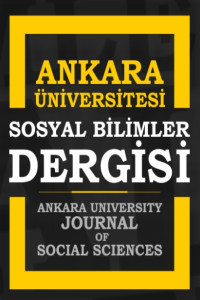SERGEY YESENİN'İN “BEYAZ SU'DA” ADLI ESERİNİN ANALİZİ
Rus edebiyatında Gümüş Çağın en parlak kişiliklerinden olan ve ortaya koyduğu eserler ile Rusya'da şiir sanatının önde gelen isimlerinden biri olan Sergey Yesenin (1895-1925) iki yüz ellinin üzerinde şiir, kırkın üzerinde anlatı şiiri kaleme almış, bu edebi türlerin dışında düz yazı türünde de eserler vermiştir. Bu eserlerinden bir tanesi de Türkçeye “Beyaz Su'da” olarak çevirebileceğimiz “У белой воды' (U beloy vodı) adlı hikâyesidir. Hikâyede yazar eşinin dönüşünü bekleyen kadın kahramanın
ruhsal ve fiziksel acılarını anlatmaktadır. Hikâye, herhangi bir mesaj verme amacı gütmeden olağan şekliyle aktarılmaktadır. Ancak yazar hikâyede anlatımı kuvvetlendirmek ve anlatılmak istenen düşüncelerin ifadesel gücünü arttırmak adına söz sanatlarına başvurmaktadır. Eserde kullanılan benzetme, metafor ve betiler anlatımı kuvvetlendirirken, semboller, imgeler ve örtmeceler okura doğrudan ifade edilmeyen durum, kişi ve olayları canlı bir şekilde zihninde canlandırma amacı taşımaktadır. Bu çalışmada daha önce Rusçadan Türkçeye çevrilmemiş bir eser olmakla birlikte incelenmemiş olan “Beyaz Su'da” adlı hikâyenin özünün anlaşılması, eserde kullanılan söz sanatlarının analiz edilerek incelenmesi amaçlanmaktadır.
Anahtar Kelimeler:
Yesenin, Düzyazı, Söz sanatları, Gümüş çağı, Rus edebiyatı
ANALYSIS OF SERGEY YESENIN'S STORY “BY THE WHITE WATER”
Sergey Yesenin (1895-1925), one of the brightest personalities of the Silver Age in Russian literature and one of the leading names in the art of poetry in Russia with his works, wrote over two hundred and fifty poems and over forty narrative poems, apart from these literary genres, he has works written in prose as well. One of these works is the story "У белой воды' (U beloy vodı), which we can translate into Turkish as "By The White Water" (U Beloy vodı ). In the story, the author describes the spiritual and physical pain of the heroine who awaits the return of her husband. The story is told as it is, without the intention of giving any message. However, the author uses rhetoric in order to strengthen the narrative in storytelling and to increase the expressive power of the ideas to be told. While the similes, metaphors and gures used in the work strengthen the narrative, symbols, images and euphemisms aim to vividly visualize situations, people and events that are not directly expressed to the reader. In this study, it is aimed to understand the essence of the story called "By The White Water", which has not been studied before and has not yet been translated from Russian to Turkish, also to analyze and examine the rhetoric used in the work.
Keywords:
Yesenin, Prose, Rhetoric, Silver age, Russian literature,
- Başlangıç: 2009
- Yayıncı: Ankara Üniversitesi
Sayıdaki Diğer Makaleler
TÜRK-ALMAN MÜZİK SANATÇILARININ KULLANDIĞI LAKAPLARIN ETİMOLOJİK VE MORFOLOJİK İNCELEMESİ
LAOZİ EPİSTEMOLOJİSİNDE ZITLIKLAR VE ÇELİŞKİ İZLENİMLERİ
TÜRKİYE'DEKİ BİLİM MERKEZLERİ VE BİLİM MERKEZLERİ İÇİN İŞLETME MODELİ ÖNERİSİ
İŞ KAZASI VE MESLEK HASTALIĞINDAN SORUMLULUKTA GEÇERLİ YETKİ DEVRİ
Aslı TENDERİS, Ömer Samet KAZDAL
OKULLARDA ALGILANAN YÖNETİCİ-ÖĞRETMEN ÇATIŞMASI VE ÇÖZÜM ÖNERİLERİ
BİR İYİLEŞME PROJESİ: GLORIA ANZALDUA'NIN SINIR TEORİSİ
ALMAN BASININDA TÜRKLERİN ÖTEKİLEŞTİRİLMESİ: BILD GAZETESİ ÖRNEĞİ
SERGEY YESENİN'İN “BEYAZ SU'DA” ADLI ESERİNİN ANALİZİ
